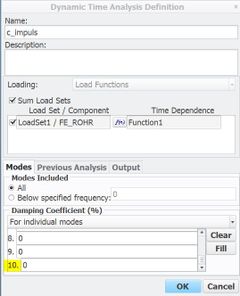Community Tip - You can subscribe to a forum, label or individual post and receive email notifications when someone posts a new topic or reply. Learn more! X
- Community
- Creo+ and Creo Parametric
- Analysis
- Re: dynamic frequency analysis - different damping...
- Subscribe to RSS Feed
- Mark Topic as New
- Mark Topic as Read
- Float this Topic for Current User
- Bookmark
- Subscribe
- Mute
- Printer Friendly Page
dynamic frequency analysis - different damping coefficient for individual modes
- Mark as New
- Bookmark
- Subscribe
- Mute
- Subscribe to RSS Feed
- Permalink
- Notify Moderator
dynamic frequency analysis - different damping coefficient for individual modes
I have a question regarding Dynamic Frequency Analysis (DRA). The FEA model that I am working on have quite a few modes (20). I want to run the DFA using different damping values for different modes but I only see field to enter different damping values is limited to only 4 modes. Is this a bug or is there another way I can enter different damping values for different modes. Am I missing something ?
Normally based on the structural complexity, I have anywhere from 15-100 modes for different systems that I analyze. FYI, I am using Creo 4.
Thanks !
Solved! Go to Solution.
- Labels:
-
Simulate
Accepted Solutions
- Mark as New
- Bookmark
- Subscribe
- Mute
- Subscribe to RSS Feed
- Permalink
- Notify Moderator
It is sort of a bug. Just before defining the dynamic frequency, setup a modal analysis with the "number of modes" you want to put damping on rather than "all modes in frequency range" Create the DFA and it will have that number of entries. If you want to change the number of modes in the normal modes you will have to create a new DFA from scratch for it to pull the right number of modes. Otherwise it will give an error The number of damping coefficients do not match the number of modes in the previous analysis "----".
On another note, if your amplitude is uniform you might be able to accept the default uniform function and change the value to 1 "grav".
Also, just in case The direction vector X=1,Y=1,Z=1 does not give the same result as running separately 1g in X,Y, Z directions. (for example I typically run three separate DFA, with 1,0,0 then 0,1,0, then 0,0,1. ) It is still uni-directional and the 1,1,1, vector will be converted to a unit vector before applying the amplitude. (0.5774,0.5774,0.5774) You may understand this all just fine, if so let this be for others to see. I have even seen this similar thought in the lab, that X,Y,Z can be combined and done on a single axis shaker by angling the fixture to a 1,1,1 vector. (rather than separately shaking in all 3 directions or using a multi-axis shaker to shake simultaneously. Creo can do the 3 directions simultaneously like a 3-axis shaker by changing the excitation from "uni-directional translation" to "Translations and rotations". You can omit directions as needed, and do not have to fill them all in.
- Mark as New
- Bookmark
- Subscribe
- Mute
- Subscribe to RSS Feed
- Permalink
- Notify Moderator
creo 2:
- Mark as New
- Bookmark
- Subscribe
- Mute
- Subscribe to RSS Feed
- Permalink
- Notify Moderator
It is sort of a bug. Just before defining the dynamic frequency, setup a modal analysis with the "number of modes" you want to put damping on rather than "all modes in frequency range" Create the DFA and it will have that number of entries. If you want to change the number of modes in the normal modes you will have to create a new DFA from scratch for it to pull the right number of modes. Otherwise it will give an error The number of damping coefficients do not match the number of modes in the previous analysis "----".
On another note, if your amplitude is uniform you might be able to accept the default uniform function and change the value to 1 "grav".
Also, just in case The direction vector X=1,Y=1,Z=1 does not give the same result as running separately 1g in X,Y, Z directions. (for example I typically run three separate DFA, with 1,0,0 then 0,1,0, then 0,0,1. ) It is still uni-directional and the 1,1,1, vector will be converted to a unit vector before applying the amplitude. (0.5774,0.5774,0.5774) You may understand this all just fine, if so let this be for others to see. I have even seen this similar thought in the lab, that X,Y,Z can be combined and done on a single axis shaker by angling the fixture to a 1,1,1 vector. (rather than separately shaking in all 3 directions or using a multi-axis shaker to shake simultaneously. Creo can do the 3 directions simultaneously like a 3-axis shaker by changing the excitation from "uni-directional translation" to "Translations and rotations". You can omit directions as needed, and do not have to fill them all in.








